The forthcoming inauguration of the Terminal 3 theFrankfurt airport is heralded as a turning point for European air transport. After a decade of construction work and massive investment, this new facility promises to increase capacity, streamline connections and enhance the passenger experience. For travelers, airlines and the tourism industry, the opening of Terminal 3 represents more than just an extension: it is the reorganization of one of the continent's biggest hubs.
Terminal 3: a new axis for mobility and connectivity
The new hub signed Fraport aims to handle up to 19 million passengers a year, absorbing a significant proportion of the traffic currently handled by Terminal 2. This additional capacity is strategically important as demand for long-haul flights and intercontinental connections continues to grow. Scheduled to open in 2026, it will enable Frankfurt to consolidate its status as one of the world's most important airports. European hubby facilitating connections between Schengen and non-Schengen flights, and offering new rotation possibilities for airlines.
A direct impact on connections and the air network
With the arrival of Terminal 3, airlines will have access to more evenly distributed slots and optimized infrastructures to reduce transit times. The reconfiguration of gates and passenger flows is designed to improve punctuality and reduce the risk of missed connections. For long-haul operators, the modernized hub offers the opportunity to increase frequencies and open up new routes, strengthening Frankfurt's position vis-à-vis other European hubs.
Technology and passenger experience: moving upmarket
Terminal 3 incorporates advanced technological solutions designed to improve fluidity and security: CT scanners for security checks, automated baggage handling systems and intelligent guidance systems. These innovations will have a tangible effect on passenger comfort, by reducing queues and speeding up procedures. The ambition is to offer a more personalized, less stressful experience, particularly for connecting passengers and premium customers.
Sustainability and operational resilience
Terminal 3 is also being built with sustainability in mind: high-performance materials, optimized energy systems and intelligent equipment management. These choices aim to reduce the airport's environmental footprint, while strengthening its resilience in the face of hazards (weather, traffic fluctuations, supply chain constraints). For airlines and airport authorities, modernization is an asset in meeting regulatory requirements and the growing environmental expectations of customers.
Consequences for airlines, competing hubs and travellers
The gradual transfer of some fifty airlines from Terminal 2 to Terminal 3 will change the commercial and operational landscape. Some airlines will benefit from better access to intercontinental connections, while others will have to review their stopover planning and handling agreements. On a European scale, Frankfurt is strengthening its competitive position vis-à-vis other hubs such as Amsterdam, Paris and London, particularly on transatlantic routes and asymmetrical connections.
What does this mean for French and international travelers?
For passengers, the expected effect is shorter layover times, better distribution of services (catering, stores, lounges) and more reliable baggage handling. Passengers from the French provinces will find potentially simpler connections to Asia, North America or Africa, while international tourists will benefit from a better-equipped European gateway. From a tourism point of view, the ramp-up of Terminal 3 can increase capacity for peak seasons and enhance the attractiveness of the destinations served.
Key information
Terminal 3 is designed to handle up to 19 million passengers a year, with modernized screening lanes and high-performance baggage handling systems, according to Flywest.
Company migration will take place in several phases between April and June, involving the relocation of some fifty carriers and the gradual adaptation of time slots.
Integrated technologies include CT scanners for security, automated baggage sorting systems and digital orientation devices for smoother connections.
Terminal 3 aims to reduce its environmental footprint through the use of energy-efficient materials and equipment, and optimized operating procedures to minimize emissions.
On the commercial front, the opening should provide airlines with opportunities to increase long-haul frequencies and develop corridors to North America, Asia and Africa, reinforcing Frankfurt's position as the nerve center of the European network.




